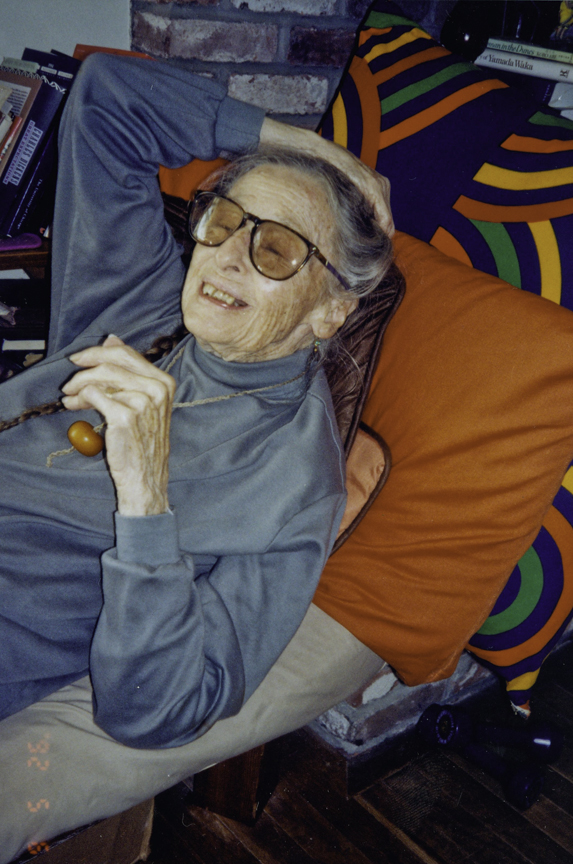
Susie Steinbach
Mary Eleanor (Susie) Parsons Steinbach (1908-2003) was born and raised in Louisville, Kentucky. Mary Eleanor graduated from the University of Louisville in 1924 with a degree in English, then worked as a reporter for the Herald-Post in Louisville. She was re-named by her agency supervisor while a social case worker in Chicago ('You look like a Susie'). In 1934, Francis Wald, a work friend, invited her home for dinner to meet H. Burr Steinbach, a colleague of Frankie's husband George Wald at the University of Chicago. After dinner, they had a friendly argument about Platonic vs Aristotelian ideals. According to Susie, 'He was for Aristotle, I was for Plato'. According to Burr, 'she looked so cute, sleeping with the cat in front of the fireplace'. In any event, they were soon married, in part to facilitate living together in Woods Hole where Burr was doing summer research. Along with other young scientists, they lived on the Heilbrun property off School Street on Eel Pond. Realizing that Burr would be spending his time in the lab, Susie joined him, often reading aloud to the likes of Jean Clark, Katsuma Dan, Dannie Mazia, and, of course, Burr. They returned to Woods Hole every summer, missing only 1943 and 1963. They purchased a cottage on Minot (now Mast) road, and many scientists walked and talked their way up Whitman Hill after a Friday night lecture for more talk, and an occasional contretemps with a persistent skunk.
Bell Tower Lane in Woods Hole became their home-base in 1970, after Burr took on the Directorship of MBL and the Do-Re-Me houses were razed to make way for Swope. Susie was always active in community, national and international politics, whether in St. Louis, Minneapolis, Chicago, Washington DC, London, Honolulu, Fort Pierce or Woods Hole. A member of the World Federalists and WILPF, she was a fervent Democrat. She was actively opposed to every war after World War II and participated in peace vigils, marches, and demonstrations. She levitated the Pentagon during the landmark anti-war demonstration of 1967. In Woods Hole, she revived the Teen Center in the basement of the Community Hall, and dared to schedule 'Last Tango in Paris' as part of a movie series, raising eyebrows and even ire in this self-identified progressive community. Susie wrote every day -- even a shopping list or a child's lunch became a vehicle for a thought or an invocation. She wrote that "a woman's mind is a crowded, spacious, lonely cave, with picture windows.. Under the bed and in the corners of the cave, invisible at first glance, are the bits and pieces, the invisible bones of her experience. She keeps peeling these off to rummage sales and relatives, but she never parts with the last piece which may be the first piece or one along the way. Come into my cave". Jane Atwood dedicated her book of photographs of blind children "to Susie Steinbach, who always loved all children as her own".
From Tatsui and Nobuko Haneji, writing from Tokyo after hearing of Susie's death, came these words: "We remember Susie in our nice memory in Woods Hole. We attended her 80th birthday party. Nobuko visited her garden every week to learn English. Her pet dog Little Brother quietly attended the lesson." In 1969 in Woods Hole, Susie wrote, "People, not abstractions, make war, make policies, make politics, can make peace. But since we have not freed ourselves to love our neighbor we must work faster for understanding, for knowledge, for facts. The young can love, nor have they as yet given up understanding. But we have left them so little time. Our love to you, for peace and its beautiful uses. As you already know, nothing one writes quite says what we mean. But keep on trying. Love, Susie."
And as Ruth Hubbard said at Susie's memorial, "it makes no sense to speak of Susie in the past tense. She was such a strong presence! For many of us, she'll be with us as long as we live."
Mary and Alan Steinbach
